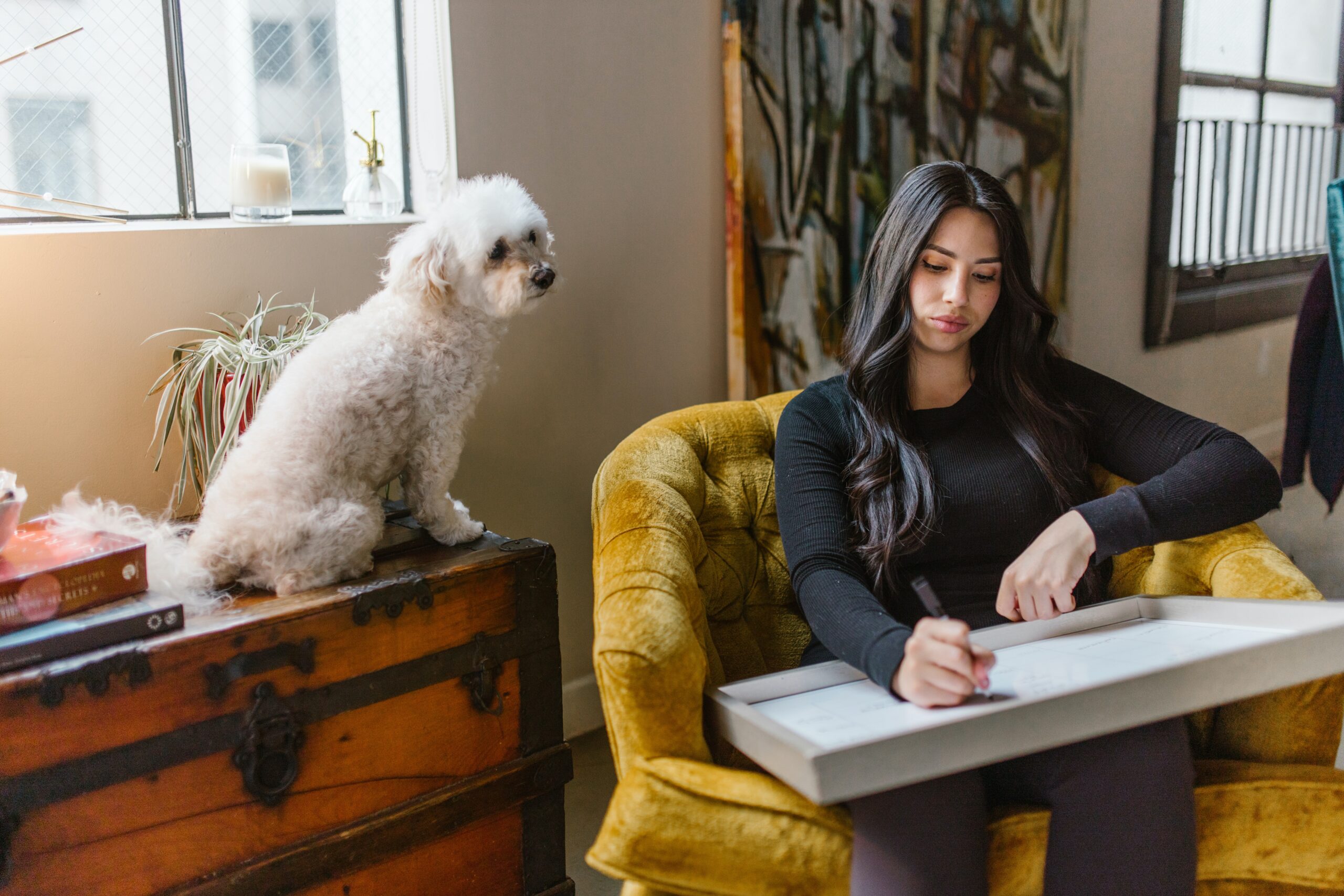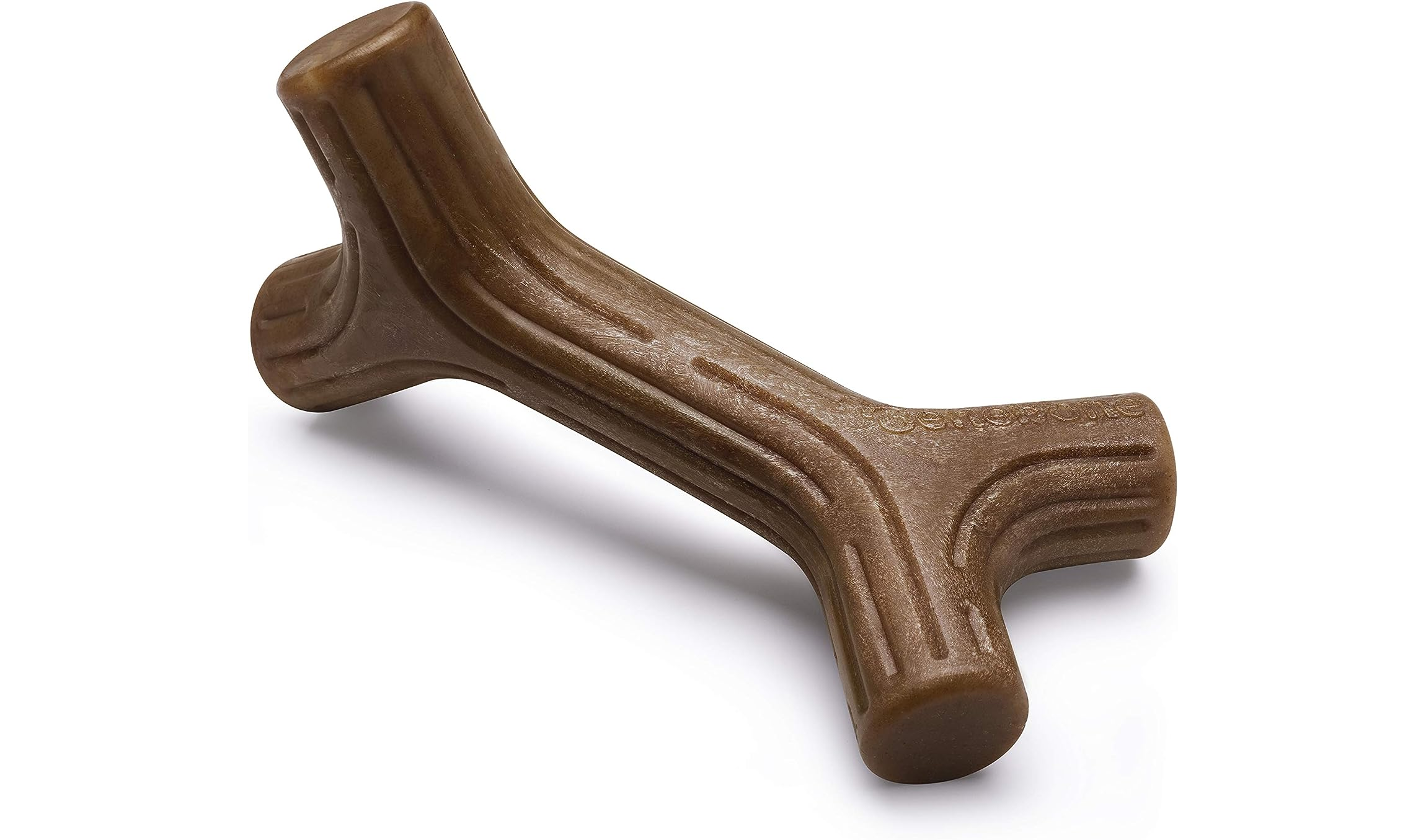Have you ever noticed your beloved canine companion choosing to sit behind you rather than by your side? This seemingly curious behavior has left many dog owners pondering the reasons behind it. In households around the world, dogs often exhibit this tendency, positioning themselves strategically behind their owners. Whether you’re engrossed in a movie on the couch or simply going about your daily routine, your furry friend might opt for a spot just out of your direct line of sight. While it might appear puzzling at first, this behavior holds intriguing insights into the intricate world of canine communication and behavior.
Our connection with dogs stretches back thousands of years, evolving from wild wolves into the loyal and affectionate companions we cherish today. However, even with this deep-rooted history, there remain aspects of canine behavior that continue to mystify us. Unraveling the reasons behind why dogs choose to sit behind their owners can provide a fascinating glimpse into their instincts, emotions, and social dynamics.
Dogs, much like humans, communicate in nuanced ways. From wagging their tails to tilting their heads, these actions convey a rich tapestry of emotions and intentions. As responsible pet owners and enthusiasts, delving into the motivations behind behaviors like sitting behind us can lead to stronger bonds and a greater appreciation for the unique individuality of our four-legged friends.
In this article, we will embark on a journey to explore the multifaceted reasons why dogs often choose this particular seating arrangement. By delving into their evolutionary history, communication cues, social triggers, and individual personalities, we hope to shed light on the intriguing world of canine behavior and deepen our understanding of the beloved companions who share our lives.
The Canine Instincts and Evolutionary Factors
Discussion on Dogs’ Natural Instincts and Behaviors
- Pack Mentality and Hierarchy
Dogs are descendants of wolves, animals known for their strong pack mentality. In the wild, wolves form close-knit social groups where each member has a distinct role within a hierarchical structure. This ingrained instinct for pack dynamics has carried over to domestic dogs. When your dog chooses to sit behind you, it could be a subtle reflection of their natural inclination to establish a position within a social hierarchy.
Observing this behavior in a household context, your dog might perceive you as the pack leader. By sitting behind you, they might be signaling their recognition of your role and asserting their respect for your position in the family unit. - Need for Protection and Security
Dogs are hardwired to seek safety and security, both for themselves and their pack. Sitting behind you might be a way for your dog to create a physical barrier between themselves and any potential threats. This behavior harks back to their ancestors’ survival tactics, where strategically positioning themselves could provide protection from predators.
Evolutionary Factors Influencing Canine Behavior
- Ancestral Survival Strategies
The evolutionary history of dogs is intertwined with their role as hunters and gatherers. In the wild, wolves and early dogs relied on cooperative hunting to secure their meals. Choosing to sit behind you could be an expression of their inherent strategy to remain out of sight and ambush predators or prey. This behavior showcases their adaptive survival skills from a time when stealth and camouflage were essential for sustenance. - Hunting and Defense Mechanisms
Dogs have inherited a range of traits from their ancestors that serve both offensive and defensive purposes. Sitting behind you might allow your dog to observe their surroundings with a sense of safety, mirroring the cautious approach their ancestors took when hunting or guarding their territory. This behavior aligns with their instinct to stay vigilant while minimizing exposure to potential dangers.
Understanding these deep-seated instincts and evolutionary factors provides valuable insights into why your dog might opt for a spot behind you. While our modern living environments have evolved significantly, these behaviors offer glimpses into the rich tapestry of canine history and the intricate ways in which they navigate their world. In the next section, we will delve into the role of communication and bonding, shedding light on how sitting behind you might serve as a form of interaction between you and your furry companion.
Communication and Bonding
Canine Communication Cues
- Body Language and Posture
Dogs are master communicators, using their bodies to convey a wide range of emotions and intentions. When your dog sits behind you, pay attention to their body language. Are their ears relaxed or alert? Is their tail tucked or wagging? These cues provide valuable insights into their current state of mind. A dog with a relaxed posture might be indicating comfort and trust, while a tense posture could suggest apprehension or uncertainty. - Eye Contact and Facial Expressions
Canine communication extends to their eyes and facial expressions. Although dogs cannot speak, their eyes can speak volumes. While sitting behind you, your dog might periodically glance in your direction or avert their gaze. Eye contact can signify various emotions, from affection and submission to curiosity and even a desire for guidance. By understanding these visual cues, you can decipher the unspoken language your dog is using to connect with you.
Expression of Trust and Affection through Positioning
- Symbolic Meaning of Sitting Behind
The act of sitting behind you can hold symbolic meaning for your dog. In the canine world, physical proximity carries significant emotional weight. By choosing to be close to you, albeit from a slightly hidden vantage point, your dog could be demonstrating their reliance on your presence. It’s a subtle way for them to say, “I trust you and feel secure in your company.” - Comparison to Human Interactions
This behavior can be likened to human interactions as well. Think about how we might position ourselves in social situations. When in a group, we often align ourselves with those we feel most comfortable around, sometimes even standing slightly behind or beside them. Similarly, your dog’s choice to sit behind you could mirror this inclination for companionship and emotional connection.
Sitting behind you isn’t just a casual choice of seating for your dog; it’s a form of nonverbal communication and a display of their emotions and attachments. This behavior underscores the depth of the bond you share with your furry friend and provides a glimpse into the intricate ways in which they express their feelings. In the next section, we’ll explore the environmental and social triggers that might influence your dog’s seating preferences in various contexts.
Individual Personality and Behavior
Impact of Dog’s Personality and Temperament
- Shy and Timid Dogs vs. Confident Dogs
Just as humans possess distinct personalities, dogs too exhibit a wide range of temperaments. Shy and timid dogs might be more inclined to sit behind you as a way of seeking protection and minimizing exposure to potential threats. These dogs might view your presence as a source of reassurance, using your physical presence as a shield.
On the other hand, confident dogs might choose to sit behind you to maintain a vantage point from which they can observe their surroundings. Their confidence allows them to balance social interactions while ensuring their own comfort and safety. - Attachment Styles and Separation Anxiety
Dogs with varying attachment styles can also influence their seating preferences. A dog with a strong attachment to their owner might prefer sitting behind them as a way of staying close, seeking comfort, and reducing separation anxiety. Conversely, dogs with more independent attachment styles might choose this position as a way of maintaining a sense of control over their environment.
Role of Early Socialization and Past Experiences
- Rescue Dogs and Traumatic Backgrounds
Dogs with a history of trauma or negative experiences might exhibit distinct seating preferences. Rescue dogs, in particular, could opt for a spot behind you as a defensive response, using your presence as a shield against potential threats. This behavior reflects their learned survival strategies from past situations. - Puppyhood Experiences and Human Interactions
Early experiences play a pivotal role in shaping a dog’s behavior. Dogs that received positive interactions and nurturing during their puppyhood might be more socially inclined and choose to sit close to their owners, regardless of positioning. Alternatively, puppies that lacked early socialization might resort to sitting behind you as a means of maintaining a cautious distance until they feel more at ease.
Understanding the interplay between a dog’s personality, past experiences, and seating preferences offers a glimpse into the complex world of canine psychology. Each dog is an individual with their own set of emotions, history, and inclinations. By acknowledging these factors, we can better appreciate the uniqueness of our furry companions and provide tailored care and support.
In the next section, we’ll address common misconceptions surrounding the behavior of dogs sitting behind their owners, helping to clarify any misunderstandings and ensure the well-being of our canine friends.
Addressing Common Misconceptions
Misinterpretations of Canine Behavior
- Submissive Behavior vs. Affection
One common misconception is the misinterpretation of a dog’s behavior when they choose to sit behind you. While it’s true that submissive dogs may display behaviors like crouching or avoiding direct eye contact, sitting behind you is not always a sign of submission. In fact, this behavior can often be an expression of affection and companionship. Dogs have various ways of showing their bond with humans, and sitting behind you could be their unique way of seeking closeness and connection. - Correcting Misunderstandings about Positioning
It’s important to avoid jumping to conclusions about your dog’s intentions based solely on their seating preference. Assuming that a dog sitting behind you is always nervous or anxious oversimplifies their complex behavior. Dogs’ actions are influenced by a combination of instincts, experiences, and emotions. By refraining from hasty assumptions, you can better appreciate the nuanced reasons behind their chosen spot.
Recognizing Signs of Discomfort or Fear
- Identifying Stress Signals
While sitting behind you can be a normal behavior, it’s crucial to be attentive to signs of discomfort or fear. Dogs communicate primarily through body language. If your dog accompanies their seating preference with signs like flattened ears, a tucked tail, or tense body posture, they might be indicating unease. Paying attention to these cues can help you gauge their emotional state. - Ensuring the Dog’s Well-being
As a responsible dog owner, your priority is your pet’s well-being. If you consistently notice stress signals or behaviors that seem out of character, consult a veterinarian or a professional dog behaviorist. Addressing any potential issues promptly can prevent the development of anxiety or other emotional challenges and ensure that your dog’s physical and emotional needs are met.
By dispelling misconceptions and taking a thoughtful, informed approach to your dog’s behavior, you can foster a deeper connection and understanding. Remember that every dog is an individual with their own personality and motivations. Our final section will provide practical tips for strengthening the human-dog bond and enhancing the overall well-being of your furry companion.
Addressing Common Misconceptions
Misinterpretations of Canine Behavior
- Submissive Behavior vs. Affection
One common misconception is the misinterpretation of a dog’s behavior when they choose to sit behind you. While it’s true that submissive dogs may display behaviors like crouching or avoiding direct eye contact, sitting behind you is not always a sign of submission. In fact, this behavior can often be an expression of affection and companionship. Dogs have various ways of showing their bond with humans, and sitting behind you could be their unique way of seeking closeness and connection. - Correcting Misunderstandings about Positioning
It’s important to avoid jumping to conclusions about your dog’s intentions based solely on their seating preference. Assuming that a dog sitting behind you is always nervous or anxious oversimplifies their complex behavior. Dogs’ actions are influenced by a combination of instincts, experiences, and emotions. By refraining from hasty assumptions, you can better appreciate the nuanced reasons behind their chosen spot.
Recognizing Signs of Discomfort or Fear
- Identifying Stress Signals
While sitting behind you can be a normal behavior, it’s crucial to be attentive to signs of discomfort or fear. Dogs communicate primarily through body language. If your dog accompanies their seating preference with signs like flattened ears, a tucked tail, or tense body posture, they might be indicating unease. Paying attention to these cues can help you gauge their emotional state. - Ensuring the Dog’s Well-being
As a responsible dog owner, your priority is your pet’s well-being. If you consistently notice stress signals or behaviors that seem out of character, consult a veterinarian or a professional dog behaviorist. Addressing any potential issues promptly can prevent the development of anxiety or other emotional challenges and ensure that your dog’s physical and emotional needs are met.
By dispelling misconceptions and taking a thoughtful, informed approach to your dog’s behavior, you can foster a deeper connection and understanding. Remember that every dog is an individual with their own personality and motivations. Our final section will provide practical tips for strengthening the human-dog bond and enhancing the overall well-being of your furry companion.
Practical Tips for Strengthening the Human-Dog Bond
Creating a Secure and Comfortable Environment
- Providing Cozy Spots and Safe Spaces
Designate areas within your home where your dog can feel secure and at ease. Offering cozy beds or blankets in quiet corners can give them a sense of ownership and a place to retreat when needed. These spaces allow them to observe their surroundings while feeling protected, potentially reducing their inclination to sit behind you out of caution. - Incorporating Familiar Scents and Objects
Surround your dog’s environment with familiar scents and objects. Their sense of smell is powerful, and having items with your scent or theirs nearby can provide comfort and reassurance. This can contribute to a positive and secure atmosphere, encouraging your dog to explore and interact without feeling the need to constantly position themselves behind you.
Positive Reinforcement and Training Techniques
- Rewarding Desired Behaviors
Reinforce positive behaviors with rewards and praise. When your dog displays behavior that aligns with your preferences—such as sitting calmly beside you instead of behind you—offer treats, pets, or verbal affirmations. This encourages them to associate desirable behaviors with positive outcomes, fostering a stronger bond and a better understanding of your expectations. - Building Confidence Through Training Exercises
Engage your dog in training exercises that promote confidence and independence. Activities like agility training, interactive games, and obedience exercises can boost their self-assurance and reduce anxiety. A confident dog may be more inclined to explore different seating options, ultimately allowing them to feel comfortable sitting beside you or in various locations.
Remember, every dog is unique, and building a strong bond takes time, patience, and understanding. By providing a secure environment and using positive reinforcement techniques, you can help your dog feel more at ease and confident, gradually reducing their need to sit behind you for safety.
In the final section of our article, we’ll recap the key points discussed and emphasize the importance of a holistic approach to understanding and nurturing your dog’s behaviors.
Conclusion
Throughout this exploration, we’ve delved into the intriguing behavior of dogs choosing to sit behind their owners. We’ve uncovered a tapestry of influences, from evolutionary instincts and communication cues to individual personality traits and past experiences. By examining these factors, we’ve gained valuable insights into the complex motivations that drive this seemingly simple action.
It’s crucial to recognize that canine behavior is a rich and multifaceted realm. Dogs, shaped by their evolutionary history and unique personalities, communicate their emotions, needs, and desires through a diverse array of behaviors. Sitting behind you is just one thread in the intricate fabric of their interactions, reflecting their natural instincts, social dynamics, and emotional connections.
As pet owners and enthusiasts, our relationship with dogs goes beyond the surface. By taking the time to understand the nuances of their behavior, we can create a more harmonious and fulfilling bond. It’s essential to approach their actions with an open mind and a willingness to learn. Each dog is an individual with their own story, and by fostering a deeper understanding, we can provide the love, care, and support they deserve.
In the journey to comprehend why your dog might choose to sit behind you, we’ve uncovered layers of meaning and insight that extend beyond the surface. By embracing their uniqueness, respecting their signals, and creating a secure environment, we can strengthen our connection with these remarkable beings who bring so much joy and companionship to our lives. So, let us continue to observe, learn, and grow alongside our canine companions, building a bond founded on trust, empathy, and a genuine appreciation for the complexity of their behavior.










